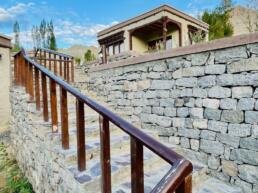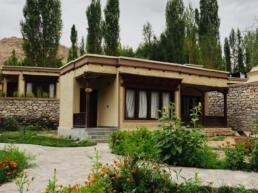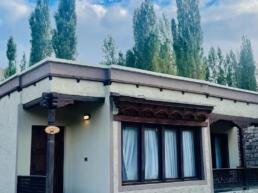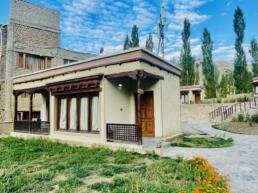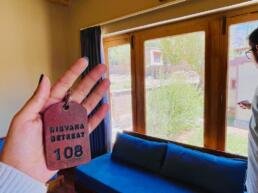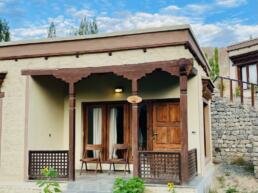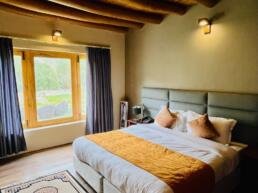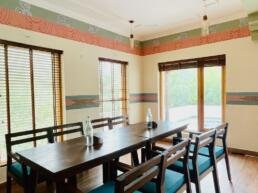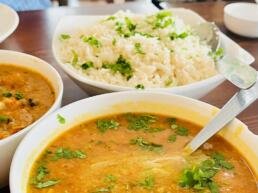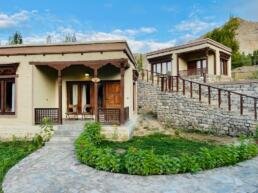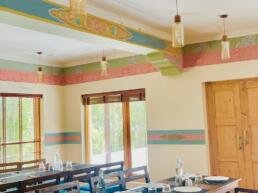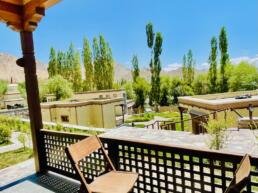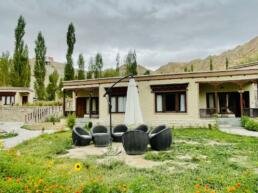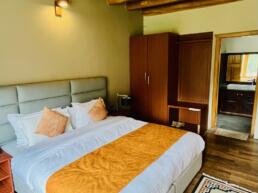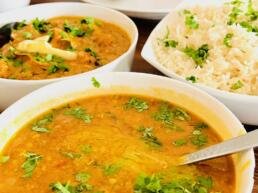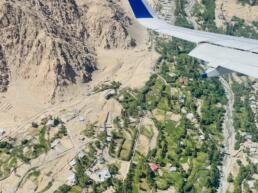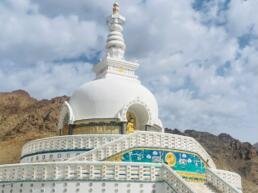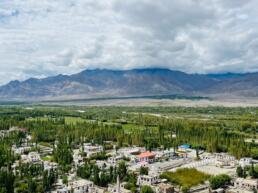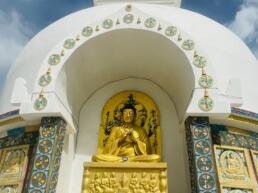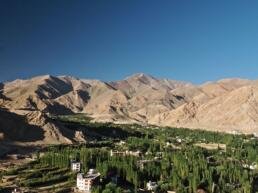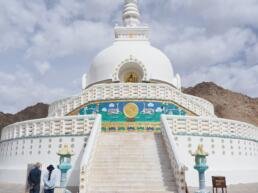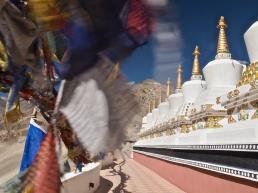Let’s just set the record straight - for a girl who grew up with severe asthma, high altitudes were a no-go. The Himalayas? Not a fleeting thought.
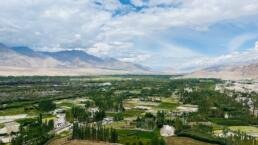
It was 2006, when my father (a photography enthusiast) visited Ladakh with a bunch of old pals for the first time. And 2016, when Akshay, my partner in both work and balance (also the Founder of OnTheMove) visited Ladakh for the first time with his photography gang. When the two finally met, for the first time :), two-thirds of the table conversation was about this very place. They both had this quiet shine in their eyes as they spoke about their experiences in the ‘roof of India’, and while sitting there relieved to see them hit it off – I of course, had nothing to add. So I made a wish.
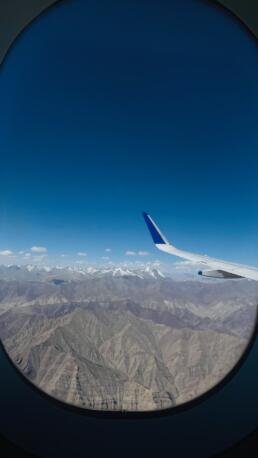
“Ladakh challenges its explorers—both in breath and in patience. It’s not the kind of place you visit on a whim. Only those who genuinely, deeply seek it, manage to make it to the end”, my dad would say with sincere passion, and pride.
In his defence, he visited Ladakh in a time when the internet was still a smidge away from our fingertips, Lonely Planet references were the gospel truth – and 3 Idiots hadn’t been released yet.
In the new decade, it was only fair we took the torch ahead. And while I didn’t know about containing the entirety of Ladakh, Leh? Leh felt a little attainable. It had an airport after all! And to make things more adventurous, we swapped our usual crew with two 65 year olds (our parents) and two 75 year olds (their siblings) to join the party!

So, there we were, four senior citizens, Akshay, and me (an asthmatic), descending from the bustling chaos of sea-levelled Mumbai into the thin, crisp air of Leh at 11,500 feet. It was a trip we’d planned meticulously, knowing that the altitude would challenge our lungs and stamina. As the plane touched down, my first impression was how the stark, ochre landscape seemed to stretch endlessly, broken only by monasteries perched on cliffs and ribbons of green fields near the Indus River.
“
“You’re holding your breath already, and we haven’t even stepped out yet”, Akshay nudged me!
“
Having flown directly into Leh rather than taking the scenic but demanding roadways from Srinagar or Delhi, we knew acclimatization was crucial for our family and us. Thankfully, The Nirvana Retreat, where we stayed for 4 days / 3 nights, was a sanctuary. From the moment we arrived, their staff seemed to anticipate our needs. They greeted us with warm Kahwa (a traditional tea brewed with spices), Khatak (a silk scarf given to guests, symbolizing goodwill and respect) and gentle advice: rest, hydrate, and let the mountains come to you.
The retreat is thoughtfully designed, with multiple wood villas equipped with heated rooms, soft mattresses, and even oxygen cylinders on standby—a reassurance for travellers young and old. The senior members of our group, initially worried about adjusting to the altitude, found solace in nourishing meals made available to us by Shankarji and the retreat staff – fresh salad, home-like phulkas, paneer, chicken, even rasgullas! – you wish it, and they try their best to make it available. The retreat also provides taxis on hire if requested in advance (self-drive cars on hire are not permitted in Ladakh, and rightfully so! It is risky, and one of the limited means of income for people in the region) – we hired an Innova, which came with an endearing driver called Padma who had the sweetest smile and a mighty good playlist.
During our first day in Leh, we only made merry with food and teas and deserving naps at the retreat. By night, we were refreshed and ready to be enthralled by some piping hot thukpas and tsampas. We ventured out into the Leh market – about 1.5kms from the retreat. And it was beyond what I expected – but somehow, true to its own.
Leh’s history reads like an epic, shaped by its position on the ancient Silk Road. For centuries, caravans laden with silk, spices, and precious stones wound through its treacherous mountain passes. Traders from Tibet, Central Asia, and India mingled here, turning the city into a vibrant melting pot of cultures.
The echoes of this past are still visible in the labyrinthine lanes and bustling bazaars. The market, a swirl of colors, scents, and sounds, brimmed with intricate handicrafts, handwoven carpets, prayer flags and delicate silver jewellery. The vendors, with their weathered faces and gentle smiles, seem to carry the weight of centuries in their eyes.
But Leh today is also a curious blend of the ancient and the modern. Akshay, who had seen it a decade ago, was both nostalgic and amused by its transformation. “There were barely any cafes then,” he mused, as we tried to choose between apple cinnamon pie and cinnamon rolls at the Buddha Cafe, “Now there’s Wi-Fi and wood-fired pizzas!”
As we walked through the streets, we passed by old stone houses, some nearly crumbling under the weight of time, others beautifully preserved with their traditional flat roofs and wooden balconies. I stopped by a grandma selling fresh baby apricots speaking impeccable Hindi with a Ladakhi accent – she gleefully handed me one – a juicy little flavour bomb, the size of a cherry, I had never had the chance to taste in my entire life!

We finally made our way into the Tibetan Kitchen in search of thukpas and tsampas — traditional Ladakhi noodle soups with a hearty broth, soft noodles, and the perfect balance of spices – it was the ideal comfort food for our first night in Leh. Set aside the fact that it was now easier to find parathas, and chinese in the Ladakhi capital than their traditional thukpas and tsampas made of barley (which, fun fact, is the most widely grown crop in the region).
Mornings at the Nirvana Retreat were always slow and beautiful. We had the view of the sunrise from our suite villa – where we sipped our morning chai everyday before heading to the dining area for the breakfast buffet. The spread was always wholesome and complete – cereals, milk, eggs, chole bhature, sandwiches, parathas, poha – something for everyone. When we informed the staff about food intolerances of the senior members in our group, they would ensure to make adjustments in advance.
On our second day, we visited Leh Palace to get a closer experience of the erstwhile royal residence. Made of stone and mud, it is modeled after the Potala Palace in Tibet, with its tiered structure and traditional Ladakhi architectural style. As you ascend the narrow, winding stairs, you’re greeted by stunning panoramic views of Leh town, the Indus Valley, and the surrounding mountains. The higher you go, the more dramatic the vistas become.
Inside, the palace is largely in ruins, but remnants of the former royal splendor remain — like intricate woodwork, ancient murals, and prayer rooms. The upper floors also provide views of Shanti Stupa and the Zanskar Range. The palace is less crowded than other tourist spots in Leh, giving you a chance to explore its history at your own pace.
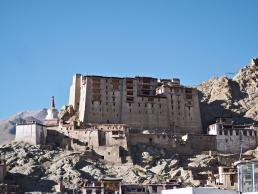
We made it in time for sunset at the Shanti Stupa, which was located only 0.5kms from the Nirvana Retreat – a white-domed Buddhist stupa on a hilltop, built to promote global peace and commemorate the 2,500th anniversary of Buddha’s enlightenment. Visiting the Stupa is highly recommended during dusk, to watch the sun dip behind the mountains casting long shadows over the valley, bathing the entire landscape in soft, warm hues of pink and golden.
After a night of rest and repair from some AMS related symptoms, we made our way to the Thiksey Monastery about 45 kms from Leh – a place of deep spiritual significance and nestled in the foothills of the Zanskar Range. Thiksey is a Gelugpa (Yellow Hat) monastery, one of the largest of its kind in Ladakh, part of the Gelug school of Tibetan Buddhism. The landscape surrounding the monastery, dotted with rugged cliffs and distant snow-capped peaks, creates a sense of isolation that enhances the monastery’s beauty. For those who enjoy hiking or photography, the sight of the Thiksey Monastery against this dramatic backdrop is otherworldly.
And as we sat in one of its courtyards, the sounds of the wind and distant chants filled the air, there was a sense of timelessness. If you happen to visit during the Hemis Festival (June/July), the monastery comes alive in an entirely different way. The calm and quiet bursts into sound and movement. Mask dances performed by monks, adorned in vibrant costumes, reenact stories of Buddhist legends and important teachings.

After spending our evening at the monastery, I headed out looking for our driver Padma and found him stacking rocks, or Chorten, as the Ladakhi call stone cairns. Intrigued, I asked him what it signifies . “In Ladakh, we believe the mountains are sacred and alive, and by stacking these stones, we honor the spirits of the mountains and the elements – seeking blessings and offering a prayer for safe passage.”
Sigh. It is riveting to learn how Ladakhi people share a profound and intimate connection with their land. Respectful of its challenges and symbiotic with its elements despite the harshness of it all.
On our way back, we decided to stock up on snacks for our onward journey to Nubra Valley and stopped at the Dragon Supermart – we were astounded to find items imported from USA to Korea to Japan. India knows how to take care of its visitors, I guess.

I remember mentioning my shock at finding Brazil nuts from Peru in a place as remote as Leh (where only Jio and BSNL has cellphone reception!) to one of the sales staff at this high-end supermarket. “The foreigners reign well here. Tourism has brought opportunities, but it’s also brought challenges,” he said. “The mountains are strong, but the rivers… they’re not what they used to be.”
As our trip came to an end, I reflected on the Leh I had heard about and the Leh I had experienced. Akshay was right—it wasn’t the same city as the one he had visited a decade ago. The influx of tourism and modernization had brought undeniable changes, but Leh hadn’t lost its soul. The monasteries still stood as beacons of tranquility, the mountains remained steadfast, and the Ladakhi spirit continued to thrive.
And after the day’s exploration. As we sipped on our steaming bowls, the sun began to dip behind the jagged peaks, casting the entire landscape in hues of gold and pink. It felt like the city was holding its breath, suspended between the past and the present, a timeless place that had somehow kept its soul intact.
The quiet magic of Leh, with its blend of ancient traditions and modern life, seeped into every moment of our evening. It was easy to see how this place could captivate a wanderer’s heart and leave them longing to return.
